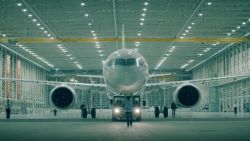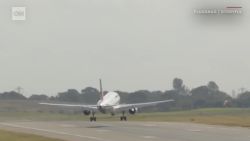Story highlights
China wants to challenge Boeing and Airbus duopoly
C919 has received 517 orders, mostly from Chinese carriers, leasing firms
FAA, U.S. aviation body, hasn't certified the plane, limiting global sales
Amid much fanfare on live national television, China on Monday rolled its first homegrown large passenger jet off the production line in Shanghai, vowing to challenge the dominance of Airbus and Boeing in the global commercial aviation market.
At the ceremony, a shiny C919 – sporting a largely white fuselage with a blue wavy stripe and a green tail – was towed beneath a banner with the phrase “a dream takes off” and past a huge Chinese national flag.
The C919 – a twin-engine, narrow-body aircraft seating up to 174 people – is similar in size to the Airbus 320 and Boeing 737 series of jets, long the workhorses for airlines around the world.
With a flying range of up to 5,555 kilometers (3,451 miles), it is designed to compete head-to-head with its Airbus and Boeing rivals, and said to easily cover popular business and leisure routes from China such as Shanghai to Singapore and Beijing to Bangkok.
Launched in 2008, the C919 project marks China’s return to the business of making large passenger jetliners, after a failed attempt in the 1980s.
Homegrown?
Although the C919’s maiden flight is at least a year away, its manufacturer, the state-owned Commercial Aircraft Corporation of China (Comac), has already made no secret of its future plans to make another, wide-body airliner.
The Communist government also wants to use the C919 as a springboard to develop a nationwide aviation industry, boasting the involvement of more than 200 companies, 36 universities and hundreds of thousands of personnel in the plane’s development.
State media are touting the “advanced technologies” used throughout the plane, from new avionics to an airframe partially made of light composite materials, as Boeing has done on its 787 Dreamliner.
However, some aviation enthusiasts in China are not so sure about the state media’s claim that the C919 is a product of “complete Chinese intellectual property.”
Compiling published information, CNN was able to verify a widely shared graphic that indicates that many key components of the C919 are made overseas – including the engines (by U.S.-French joint venture CFM International), power system and landing gears (both by U.S.-based Honeywell).
Explosive growth
One thing not in dispute is China’s hunger for new passenger jets as its aviation market continues its explosive growth.
Already the world’s second largest air travel market after the United States, China will need more than 6,300 new planes over the next two decades, according to a recent Boeing forecast.
Airbus holds a similarly bullish view and has been assembling its popular A320 family aircraft in the northern Chinese city of Tianjin since 2008.
During President Xi Jinping’s recent state visit to the United States, China signed a deal with Boeing to purchase 300 airliners worth $38 billion at list prices.
When German Chancellor Angela Merkel visited Beijing last week, China also announced that it would buy 130 Airbus jets valued at $17 billion.
End of duopoly?
Small wonder that state media are channeling Comac’s confidence about the C919’s bright future.
The company expects to sell 2,000 aircraft in the coming 20 years and some Chinese commentators even predict an A-B-C (Airbus-Boeing-Comac) three-way fight for market share in the long run.
So far, the C919 has received 517 orders, mostly from state-owned Chinese carriers and domestic aircraft leasing companies.
The lack of certification from the U.S. Federal Aviation Administration (FAA) is seen as a major hindrance for international sales.
And Chinese public reactions have seemed mixed online. While many express pride and support in an indigenous jetliner, others sound skeptical about the safety of an entirely made-in-China plane.
Some Internet users have made a point of saying they will feel comfortable flying the C919 when it is used as China’s “Air Force One.”
For now and in the foreseeable future, though, it’s a safe bet that President Xi will continue to ride a specially configured Boeing 747 jumbo jet when he travels abroad.
CNN’s Shen Lu in Beijing contributed to this report





















